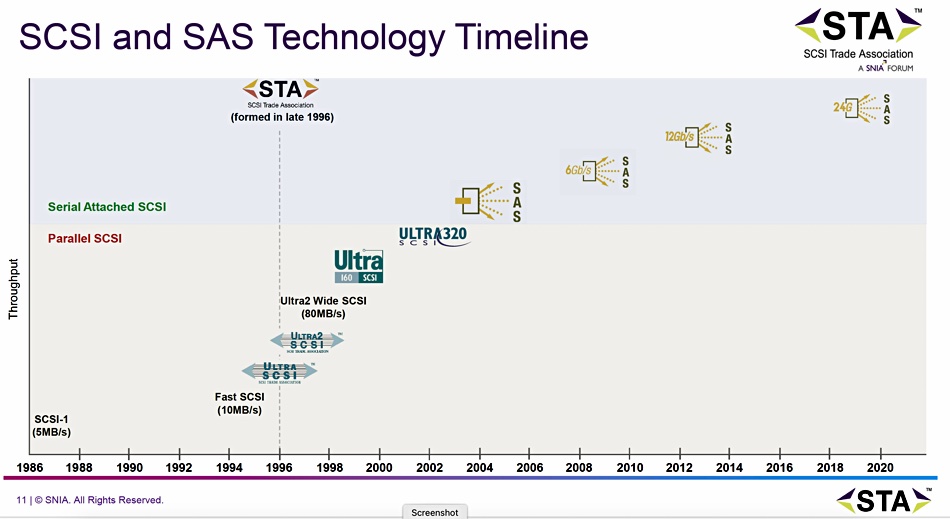NVMe is becoming the standard high speed storage drive interface, but SAS will endure for many years because of its massive installed base.
Update. Typos fixed, images improved and 24G+ speed confirmed. 28 November 2023.

The STA (SCSI Trade Association) looks after the SAS standard, and its Forum Chair, Cameron Brett, spoke of the issue in a presentation at a TechLive event in London. The STA has to develop a roadmap that progresses from the current 24G SAS standard but recognizes that NVMe is taking over from SAS as the high speed storage drive interface.
How did we get to this situation?
Prepare for nested acronym deconstruction: SAS (Serial Attached SCSI, or Small Computer Systems Interface) is an interconnect used by disk drives and SSDs. It is used along with SATA (Serial Advanced Technology Attachment) and both have replaced PATA (Parallel Advanced Technology Attachment). PATA, by today’s standards is slow, transferring data at up to 133 MBPs and supporting 80GB capacity drives. SATA is faster, transferring data at up to 300 MBps.
The current SATA standard, revision 3, defines a 6 Gbps bandwidth.
SCSI represents an upgrade to PATA and SATA as it is used for additional peripheral devices such as printers and scanners.

The SAS revision 3 or SAS-3 standard defines a 12 Gbps interface bandwidth, which matched the PCIe 3 interconnect to which SAS drives ultimately connected. SAS-4 or 24G SAS, the current standard, moves this up to 24 Gbps, and was defined by the STA in 2019/2020. It was prompted in part by the then coming PCIe 4 interface with its doubled speed over PCIe 3.
Brett said of SAS-3: “SAS/SCSI was optimized for HDDs at the time, since SSDs were not around yet. Steps have been taken over time to accommodate SSDs and take better advantage of their performance. NVMe was created from the ground up for flash-based storage, so it is better optimized for SSDs.”
SAS-3 can run over a longer cable, 12m, than SATA’s 1m length. SAS connectors support SATA connectivity but the reverse is not true.
An STA/TrendFocus chart shows that the bulk of enterprise storage capacity is represented by nearline drives and the bulk of these use the 12 Gbps SAS interface:

There are no 24G SAS disk drives and only a few 24G SAS SSD products made by enterprise storage suppliers, as the NVMe (Non-Volatile Memory Express) interconnect has taken over the SSD interface area, and high-speed disk drives, operating at the 10,000rpm level are being replaced by SSDs. That leaves the bulk of the enterprise and PC disk drive products spinning at 7,200rpm and quite happily connecting at the 12gig SAS level.
A few 24G SAS SSD products are appearing on the market – for example, Kioxia PM6 and PM7, and Samsung’s PM1653. There are various 24G SAS interconnect products, such as Broadcom’s 9600 series interfaces, plus cables, connectors, analyzers and extenders. But, by and large, 24G SAS adoption by storage drive manufacturers has been slow.
Brett however, characterized SAS as immortal, because it has such an entrenched hold in the disk drive interconnect area. He thinks SAS will be the majority HDD interface through to 2027. NVMe, which, with the NVMe v2.0 spec, has developing a disk drive extension, may eat into SAS’s disk drive hegemony over time. But the massive SAS HDD base will provide a replenishment and upgrade market that will endure for many years.
He pointed out that NVMe is optimized for flash whereas SAS is optimized for disk. With NVMe you can have four PCIe lanes on an SSD compared to single or dual SAS lanes, making the NVMe interface much faster.
The next SAS standard, which is being worked on now, will be 24G+, with a 2025/2026 definition data. Brett did say that there is no doubling of 24G speed, to 48 Gbps, being envisaged, and no 4-port SAS interface being developed. Our understanding is that 24G+ will continue to use the SAS-4 physical layer spec, and this implies no increase in speed beyond 24 Gbps. We have asked Brett to confirm this, and he said: “Yes. 24G+ will have the same physical interface speed as 24G (SAS-4) @ 22.5Gbps.”
The STA has defined 24G+ command duration limits, format wish presets and logical depopulation. It is considering attenuation, key per IO, growing the protection information field and making fairness enhancements with the 24G+ standard.
Although the STA is ceding the high-speed drive interface area to NVMe it sees a continuing role for SAS in hyperscale storage environments. Brett cited the Open Compute Project’s drive chassis standards as evidence; Knox (6Gbps SAS) in 2013, Honey Badger (12 Gbps SAS) in 2015, Bryce Canyon (12 Gbps SAS) in 2017, and Grand Canyon (14 Gbps SAS) in 2022. He thinks there will be follow ons for at least two generations, and they may well use 24G+ SAS.
Brett reckons SAS has been the dominant storage interface for nearly two decades and will be so for years to come. The STA is, he said, ensuring that SAS will continue to innovate to meet evolving datacenter needs.
Bootnote
Although 24G SAS is nominally a 24 Gbps standard each lane in a 24G SAS interconnect actually operate at 22.5 Gbps








